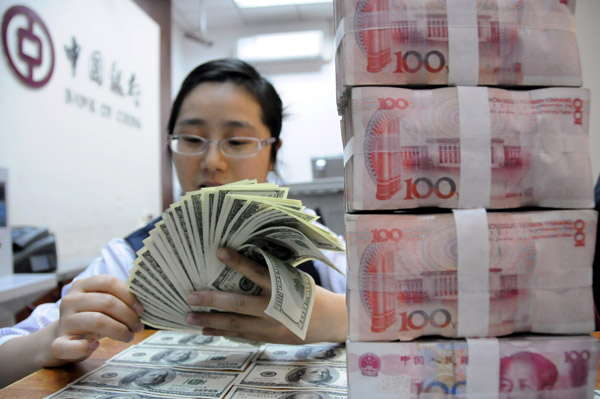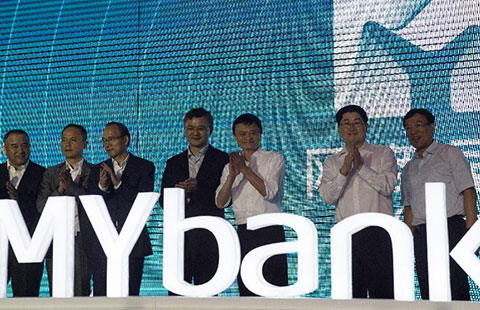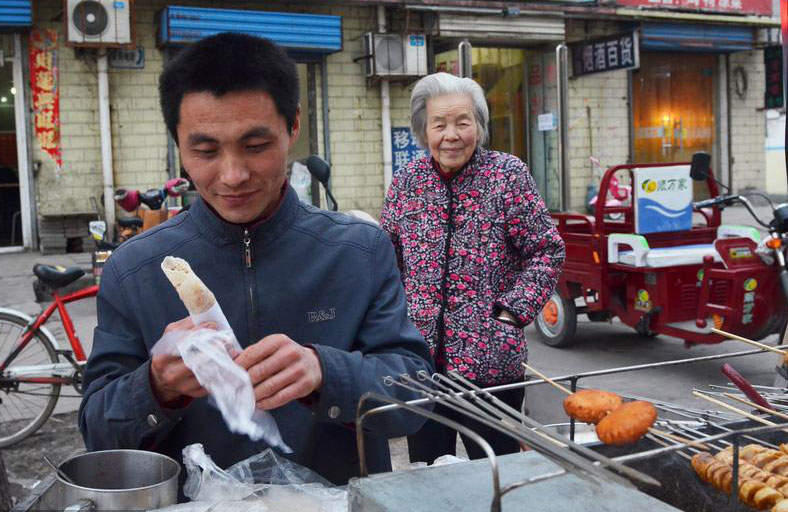China cuts reserve requirement again to support economic growth
By Chen Jia (chinadaily.com.cn) Updated: 2015-06-27 19:54
 |
|
A clerk counts currency at a Bank of China Ltd branch in Nanchong, Sichuan province. [Photo/Xinhua] |
China's central bank announced a targeted cut of reserved requirement ratio (RRR) and the year's third reduction of the one-year deposit and lending rates beginning Sunday to consolidate the moderate rebound of economic growth and ensure low financing costs for companies.
According to the People's Bank of China (PBOC), it lowered the RRR by half a percentage point of city commercial banks and non-county-level rural commercial banks that have lent a certain portion of their loans to agriculture-related firms.
The RRR of State-owned large commercial banks, joint-equity commercial banks and foreign banks that lend certain loans to small and micro businesses will also be reduced by the same rate.
For finance companies, the RRR cut is by 3 percentage points, said a statement on the PBOC's website.
At the meantime, the central bank decided to further cut the benchmark interest rates by 25 basis points. The one-year deposit rate was lowered to 2 percent, while that of the lending rate is now 4.85 percent.
The central bank has cut the interest rates for a third time this year. The deposit rate has been lowered by 115 basis points in total, and the lending rate was decreased by 100 basis points.
It is not usual to see the "double cuts" at the same time, but the central bank's move has been expected, experts said, explaining the main target is to further stabilize economic growth.
Lu Lei, head of the PBOC's research department, said that "using the quantitative and pricing tools simultaneously is a decision after a balance between stabilizing economic growth and controlling financial risks".
The targeted RRR cut, instead of a general reduction, will help to improve economic structure and support weak sectors, but prevent flush liquidity.
Lu Zhengwei, chief economist at the Industrial Bank Co, said that economic downturn pressure still remained in the second quarter, adding risk of a below-7 percent GDP growth, although it may rebound in July.
The "double cuts" will also support a rise in the stock market on Monday, said Lu.
The benchmark stock index suffered the worst single-day decline in seven years at Friday's close, as the Shanghai Composite Index tumbled by 7.4 percent, or 334.91 points, to close at 4,192.87.
About $767 billion in market value was wiped out with more than 2,000 stocks falling by the 10 percent daily trading limit.
In just two weeks, the benchmark Shanghai index has retreated by 18.8 percent from a peak of 5,166.35 on June 12. Most analysts define entering a bear market as a decline of 20 percent from a recent peak.
"It is in a crucial period to transfer the old industrial and development driving force to the new, they are arduous tasks to stabilize growth, adjust structure, promote reform, improve livelihood and prevent risks, which requires a flexible monetary policy to stabilize economic growth and reduce the financing cost," a separate statement from the PBOC said.
The relatively lower inflation and high real interest rates have provided room for RRR and a rates cut, it said.
In May, the country's domestic investment demand and exports stayed weak, although consumption remained resilient. Industrial production grew slightly faster at 6.1 percent year-on-year, up from 5.9 percent in April, showed moderate improvement as property construction stayed in deep recession and infrastructure investment faltered again.
Deflationary pressures persisted as credit growth slowed further. CPI inflation moderated to 1.2 percent year-on-year last month despite higher pork prices, while PPI declined 4.6 percent weighed down by investment and manufacturing prices.
- Taxi-hailing app Didi-Kuaidi raising $1.5 billion
- China, Kazakhstan agree to integrate growth strategies
- Agricultural cooperation association between China, CEE countries launched
- Constitution to lay cornerstone for AIIB
- New stocks board to help China's tech startups: CSRC
- JD.com joins ZestFinance to expand consumer credit in China
- Belt and Road Initiative 'crucial' for Belgian port of Antwerp: port president
- Good outlook for Chinese economy in longer term: expert

















